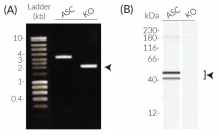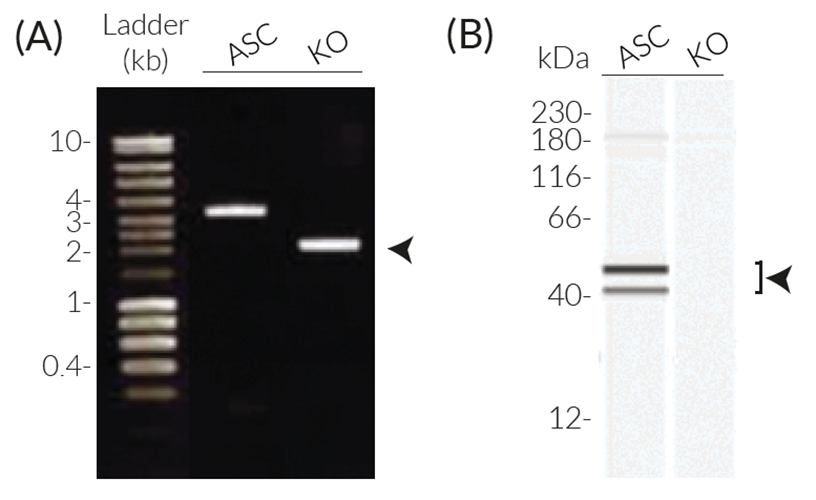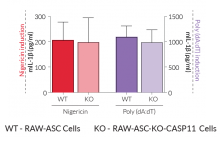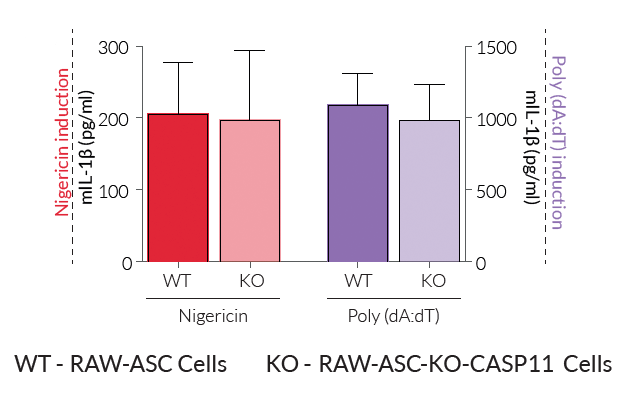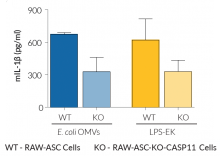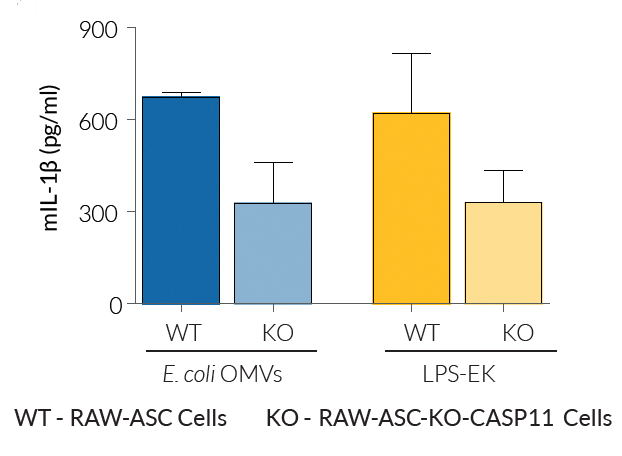Caspase-11 KO RAW-ASC Cells
| Product | Unit size | Cat. code | Docs. | Qty. | Price | |
|---|---|---|---|---|---|---|
|
RAW-ASC KO-CASP11 Cells Caspase-11 Knockout & ASC expressing RAW 264.7 cells (murine macrophages) |
Show product |
3-7 x 10e6 cells |
raw-kocasp11
|
|
Caspase-11 knockout in RAW 264.7 cells
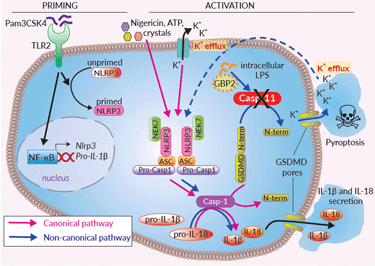
Inflammasome signaling in RAW-ASC KO-CASP11 cells
Murine caspase-11 (CASP11) is an inflammatory caspase playing a crucial role in the non‑canonical inflammasome responses to intracellular lipopolysaccharide (LPS) [1-3].
InvivoGen has generated RAW-ASC KO-CASP11 cells from the RAW-ASC cell line, which derives from the naturally ASC deficient RAW 264.7 macrophage cell line [4]. RAW-ASC KO-CASP11 cells stably express the transfected murine ASC gene and have a stable knockout of the caspase-11 (CASP11) gene.
• RAW-ASC KO-CASP11 cells – Knockout (KO) of the CASP11 gene and expression of the murine ASC gene
The secretion of mature IL-1β is impaired in RAW-ASC KO-CASP11 cells upon activation of the non-canonical (caspase-11) inflammasome when compared to the parental cell line. However, this response is comparable to the parental RAW-ASC cells upon canonical inflammasome activation. This cell line is a useful tool to study the role of CASP11 in the inflammasome responses and is an alternative to the in vitro differentiation of mouse bone-marrow-derived macrophages.
FEATURES OF RAW-ASC KO-CASP11 CELLS:
- Verified biallelic knockout of the CASP11 gene and stable expression of the ASC gene (Western blot)
- Impaired mature IL-1β secretion after non-canonical inflammasome activation by LPS
- Alternative cellular assay to the in vitro differentiation of mouse bone-marrow-derived macrophages
![]() Download our Practical guide on Inflammasomes
Download our Practical guide on Inflammasomes
References:
1. Kayagaki N. et al., 2011. Noncanonical inflammasome activation targets caspase-11. Nature. 479:117.
2. Kayagaki N. et al., 2015. Caspase-11 cleaves gasdermin D for non-canonical inflammasome signalling. Nature. 526:666.
3. Shi J. et al., 2014. Inflammatory caspases are innate immune receptors for intracellular LPS. Nature. 514:187.
4. Pelerin P. et al., 2008. P2X7 receptor differentially couples to distinct release pathways for IL-1β in mouse macrophage. J. Immunol. 180:7147.
Specifications
Antibiotic resistance: Blasticidin
Growth medium: DMEM, 4.5 g/l glucose, 4 mM L-glutamine, 10% heat-inactivated fetal bovine serum (FBS), 100 U/ml penicillin, 100 µg/ml streptomycin, 100 µg/ml Normocin™
Test medium: DMEM without phenol red, 4.5 g/l glucose, 4 mM L-glutamine, 10% heat-inactivated FBS, 100 U/ml penicillin, 100 µg/ml streptomycin.
Note: Phenol red causes high background signal in the LDH (lactate dehydrogenase) assay used to monitor inflammasome-induced cell death.
Quality Control:
- Biallelic CASP11 knockout has been verified by DNA sequencing, PCR, Western blot (Wes™), and functional assays.
- The stability for 20 passages, following thawing, has been verified.
- These cells are guaranteed mycoplasma-free.
This product is covered by a Limited Use License (See Terms and Conditions).
Back to the topContents
- 3-7 x 106 RAW-ASC KO-CASP11 cells in a cryovial or shipping flask
- 1 ml of Normocin™ (50 mg/ml). Normocin™ is a formulation of three antibiotics active against mycoplasma, bacteria, and fungi.
- 1 ml of Blasticidin (10 mg/ml)
![]() Shipped on dry ice (Europe, USA, Canada and some areas in Asia)
Shipped on dry ice (Europe, USA, Canada and some areas in Asia)
Details
CASP11 and its human orthologs CASP4 and CASP5 are "non-canonical inflammasomes" that sense intracellular lipopolysaccharide (LPS) from Gram-negative bacteria and cause inflammatory responses, independently of TLR4 [1-3]. In the context of bacterial infection, LPS can be released from lysed bacteria as “free” LPS aggregates or actively delivered to the host cell through the release of small spherical bodies that encapsulate many bacterial components (i.e. toxins, DNA, RNA, and LPS) termed outer membrane vesicles (OMVs).
CASP11 directly binds to the lipid A moiety of LPS, which features a variable number of acylated fatty acid chains depending on the bacterial strain [2,3]. Of note, CASP11 expression is weak in resting cells and can be induced through NF-κB or STAT1 activation [4]. CASP11 (and CASP4/5) cannot cleave pro-IL-1β and IL-18. However, they trigger the cleavage of the pore-forming protein gasdermin D (GSDMD), leading to the release of alarmins and K+ efflux. Ultimately, this induces the activation of NLRP3 and CASP1-mediated IL-1β/-18 maturation and secretion [3].
1. Kayagaki N. et al., 2011. Noncanonical inflammasome activation targets caspase-11. Nature. 479:117.
2. Kayagaki N. et al., 2015. Caspase-11 cleaves gasdermin D for non-canonical inflammasome signalling. Nature. 526:666.
3. Shi J. et al., 2014. Inflammatory caspases are innate immune receptors for intracellular LPS. Nature. 514:187.
4. Rathinam. et al., 2012. TRIF Licenses Caspase-11-Dependent NLRP3 Inflammasome Activation by Gram-Negative Bacteria. Cell. 150:606.





